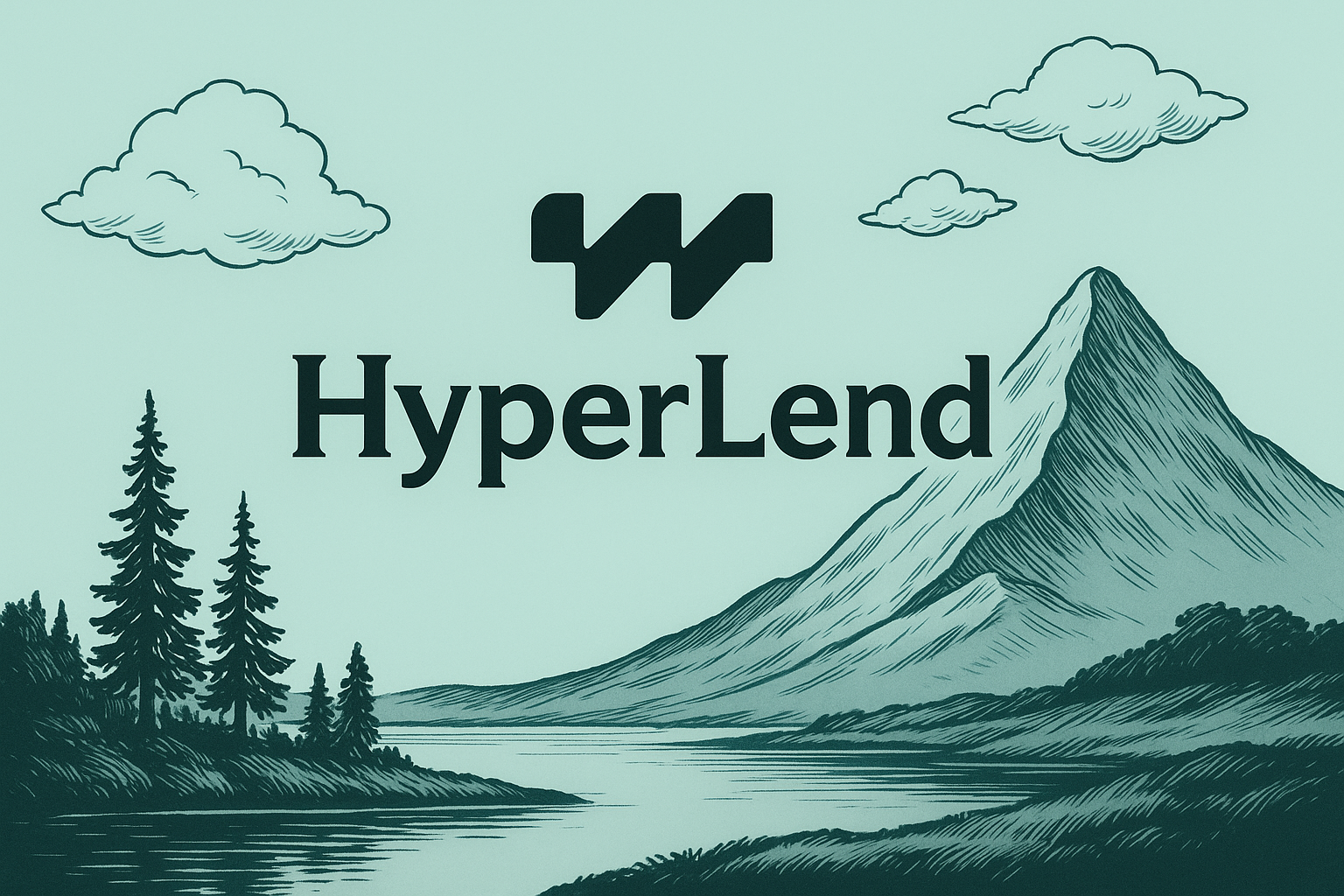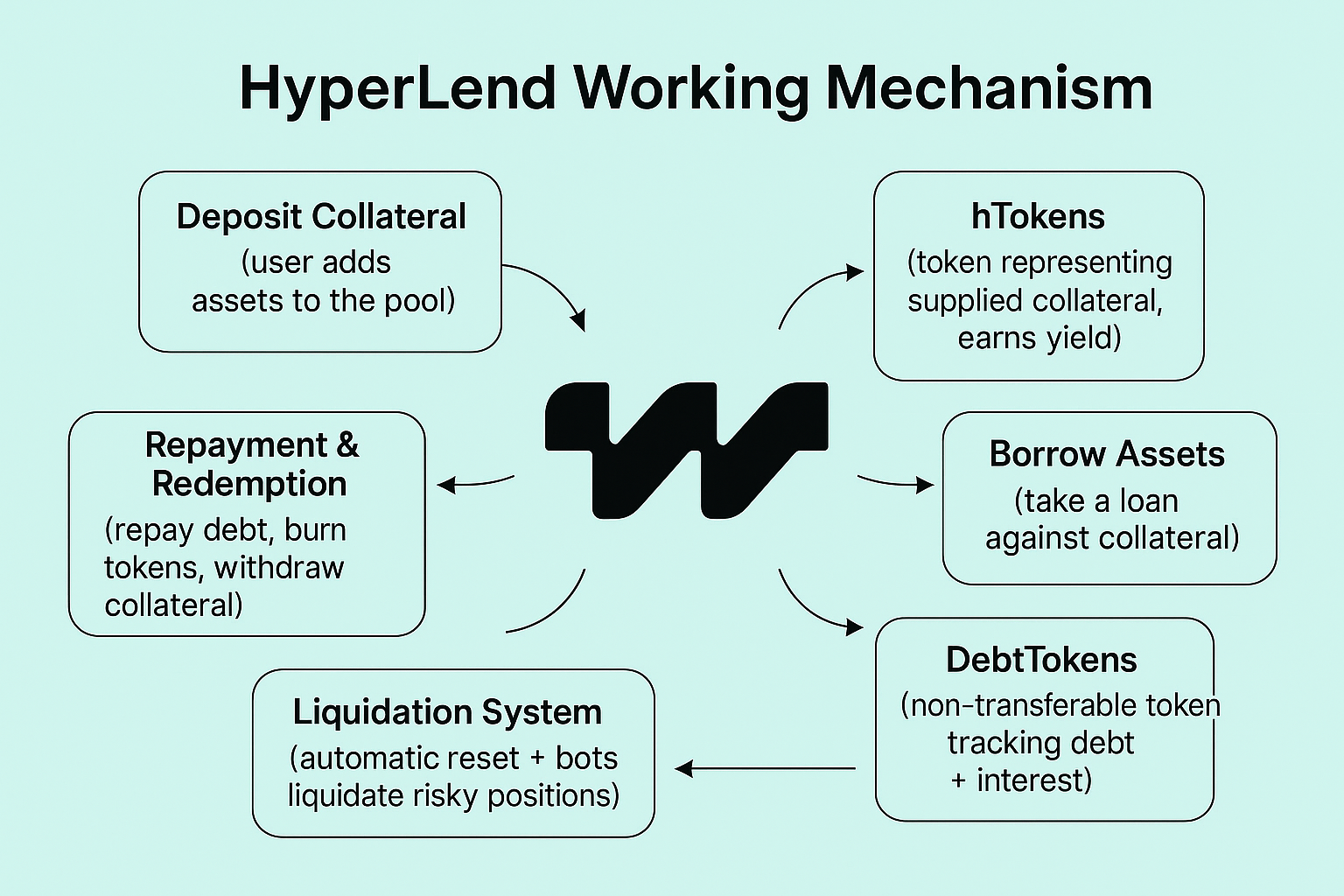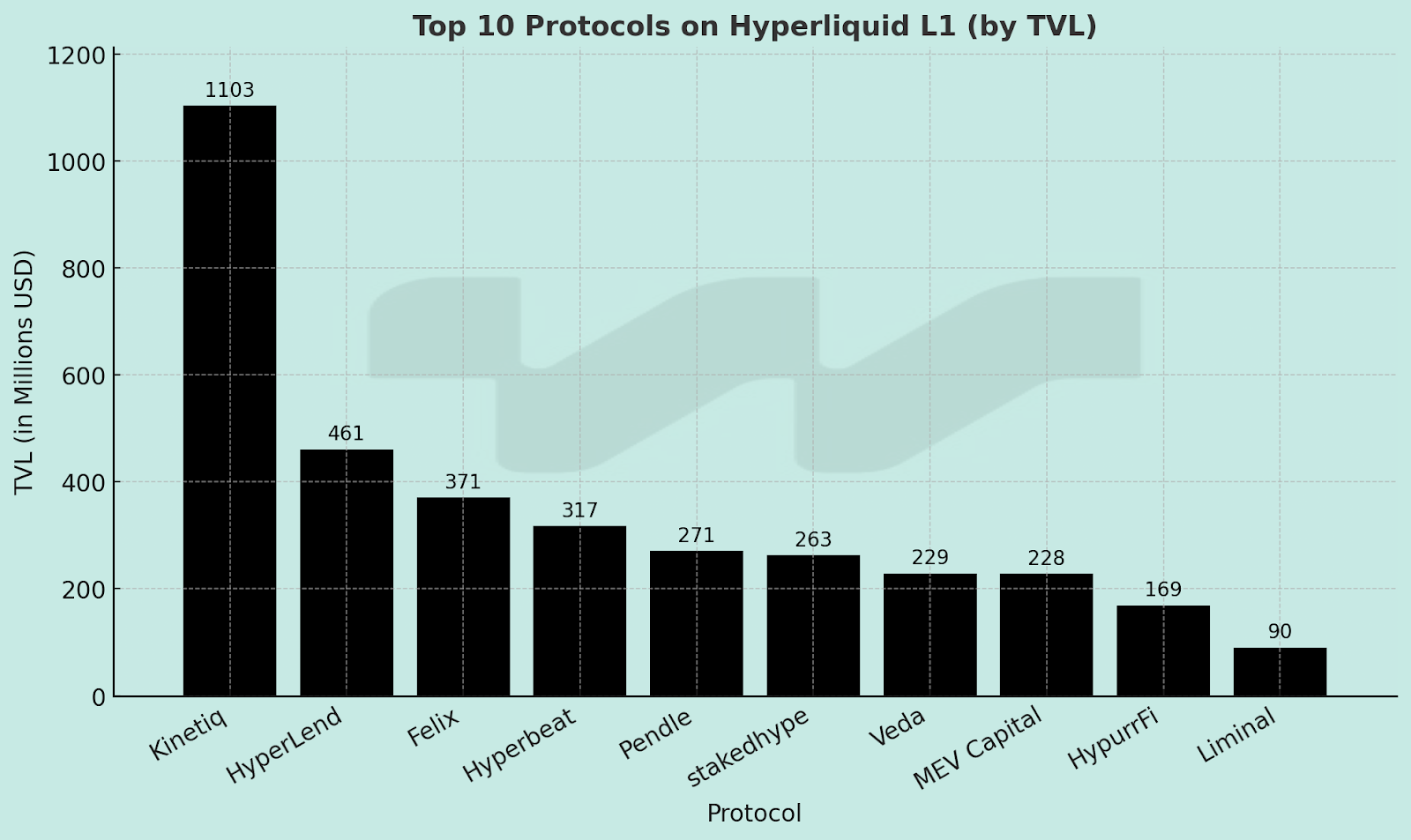.jpg)
Hyperlend: The Native Lending Engine of Hyperliquid

Hyperlend is the primary lending and borrowing protocol built natively on the Hyperliquid Layer 1 blockchain, designed to move capital at the speed of the chain’s deterministic, low-latency execution. It serves as the liquidity backbone for the Hyperliquid ecosystem, where depositors can earn yield on supplied assets and borrowers can unlock capital through transparent, composable markets. With its architecture embedded directly into Hyperliquid’s validator and execution layers, Hyperlend eliminates inefficiencies common in cross-chain or third-party lending markets.
The protocol offers a fluid user experience that appeals to both retail users and institutional participants. Retail users benefit from simple deposit-and-earn mechanics, while power users and traders gain access to leveraged positions, capital recycling, and integrations across Hyperliquid’s broader DeFi stack. Unlike generic money markets, Hyperlend is purpose-built to work in sync with the unique mechanics of Hyperliquid’s order book, ensuring that every loan, repayment, and liquidation is processed onchain without delay or hidden execution risk.
In essence, Hyperlend is more than just a place to park assets or borrow against them. It is a real-time financial layer that keeps liquidity circulating within the ecosystem, enabling builders to tap into deep capital pools, traders to deploy high-conviction positions, and stakers to maximize yield from their collateral without leaving the Hyperliquid environment.
Founders and Protocol Origins
Hyperlend was founded by a team of early Hyperliquid contributors led by 0xNessus, who identified a fundamental gap in the chain’s infrastructure: the need for a native, high-performance lending market capable of operating at the same speed and security level as the base chain itself. Their vision was to remove dependency on external lending venues and instead create a protocol that could serve the needs of all ecosystem participants from day one.
Nessus’ journey in crypto began in March 2020, buying the COVID crash dip alongside his mother on Bitstamp. He was an early participant in Olympus and quickly became deeply active in the ecosystem, setting up monitors to track forks across chains and mobilizing teams to secure presale allocations. He took part in the Lukso ICO and ran a tight-knit friends-and-family group during the NFT boom, building proprietary minting and rarity sniping bots, executing bundled NFT transactions across dozens of wallets, and maintaining one of the lowest cost bases in the space despite paying high five-figure gas fees. His group was also early to the ENS meta, minting roughly half of all Arabic 3-digit and 4-digit domains and at one point holding nearly 10% of all 4-digit ENS numbers in existence.
Like many veterans, Nessus experienced both wins and setbacks including losing 40% of his net worth in the FTX collapse. His time in the space also included heavy airdrop farming, with an automated multi-chain bot system designed to interact with up to 10 protocols per network in unique patterns to avoid detection. While most airdrops returned little financial reward, the process honed his operational expertise. He also helped design logistics for cross-chain arbitrage bots, giving him a practical edge in automation and execution at scale.
The Hyperlend team collectively brought deep expertise in DeFi architecture, risk modeling, and automated trading systems. Before launching the protocol, they had already worked on solutions for cross-collateralization, liquidation health monitoring, and market risk assessment. From day one, they adopted a hands-on approach with the community working directly with liquidity providers, traders, and developers to address challenges like slow settlement speeds and inflexible collateral rules. This constant feedback loop shaped Hyperlend’s launch, ensuring it entered the market not as a generic money market, but as a purpose-built liquidity engine designed specifically for the Hyperliquid ecosystem.
Core Mechanism: Lending and Borrowing Markets
At its core, Hyperlend operates on a peer-to-pool model. Users who supply assets to the lending pool receive a yield-bearing representation of their position, while borrowers draw from these pooled funds after posting approved collateral. Interest rates adjust dynamically based on the utilization of each pool, balancing the needs of lenders seeking returns with borrowers seeking capital efficiency.
Collateral can include stablecoins, liquid staking tokens, HYPE, and other approved Hyperliquid assets. Each asset in the protocol is assigned a loan-to-value ratio and a liquidation threshold, ensuring that borrowing remains within safe leverage parameters. If a borrower’s health factor drops too low, the protocol’s liquidation system steps in immediately to repay the outstanding debt by selling the collateral.
A distinctive feature of Hyperlend’s market design is the Automatic Reset System, which helps maintain pool stability and healthy utilization levels. Instead of relying on abrupt interest spikes or manual intervention, the system continuously monitors market conditions and automatically recalibrates rates, pool parameters, and collateral factors when thresholds are reached. This approach ensures that pools remain functional and attractive for both sides of the market, even during periods of volatility, without causing liquidity shocks or locking out borrowers.

Liquidator Bot and Automated Protection
The security and solvency of Hyperlend’s markets are reinforced by a permissionless network of liquidation bots. These bots operate continuously, monitoring every active loan onchain and executing liquidations the moment a position’s health factor falls below the safe threshold. The process is designed for speed and precision, with all liquidation transactions routed through Hyperliquid’s order book to minimize slippage and ensure debt is repaid in full.
Because participation in liquidation is open, competition among bot operators drives efficiency and reduces the chances of bad debt accumulating in the system. The bots themselves interact directly with the protocol’s smart contracts, leaving no room for human delay or offchain dependencies. This automated enforcement mechanism provides lenders with confidence that their supplied capital remains protected even during sudden market downturns.
The liquidator bot network is also a key factor in Hyperlend’s ability to support more volatile assets. By ensuring that liquidation processes are fast and predictable, the protocol can safely onboard collateral types that might otherwise pose excessive risk in slower, less automated systems.
Integration and Composability
Hyperlend is not an isolated application; it is a hub in the wider Hyperliquid DeFi stack. It integrates with protocols such as Kinetiq, allowing users to deposit yield-bearing kHYPE as collateral, and also works with USDhl for stablecoin settlement and peg maintenance, giving borrowers flexible repayment options and deepening system liquidity. This composability means that a single user flow can involve multiple protocols working together. For example, a user might stake HYPE via Kinetiq to receive kHYPE, deposit that kHYPE into Hyperlend, borrow stablecoins, and then reinvest them into other Hyperliquid-native yield strategies, all without bridging or leaving the chain.
For developers, Hyperlend’s integration points open the door to building new structured products and cross-protocol strategies. By plugging into its lending pools and collateral systems, builders can launch products that inherit Hyperlend’s liquidity, risk controls, and execution speed.
Risk Management and Liquidation Design
Managing risk in Hyperlend involves more than just enforcing collateral ratios. Each asset is onboarded with careful analysis of its price history, volatility, liquidity depth, and correlation with other assets in the protocol. Loan-to-value ratios, liquidation bonuses, and interest models are tailored for each market, ensuring that systemic risk is minimized.
Liquidations are executed entirely onchain, using Hyperliquid’s order book to sell collateral quickly and at the best available price. This design eliminates the partial fills and slippage issues common in offchain or AMM-based liquidations. By executing in the same block where the liquidation is triggered, Hyperlend ensures that market conditions at the time of liquidation are accurately reflected in the outcome.
Governance plays a role in adjusting these parameters as markets evolve. While the team retains some administrative privileges during the early stages, the long-term roadmap includes progressive decentralization so that the community can manage collateral listings, parameter changes, and risk models collectively.
Tokenization: hToken and DebtToken
Hyperlend does not issue a public governance or utility token for trading in the open market. Instead, it employs two internal tokenized systems to represent user positions.
When a user deposits assets into a lending pool, they receive hTokens, ERC-20 tokens that represent their share of the pool. These hTokens are yield-bearing, meaning their value increases over time as interest accrues from borrowers. When the underlying assets are withdrawn, the hTokens are burned, returning the principal plus accumulated interest to the user.
Borrowers receive DebtTokens, which are non-transferrable tokens representing the amount of debt they owe to the protocol. These tokens accrue interest automatically and are burned once the borrower repays their loan in full. Together, hTokens and DebtTokens form the backbone of Hyperlend’s accounting system, ensuring accurate and transparent tracking of every user position onchain.
Audits and Criticisms
In January 2025, Hyperlend completed a full smart contract audit by Pashov Audit Group, covering lending core modules, isolated pool systems, configuration contracts, and cross-chain deposit mechanisms. The audit was conducted by security researchers 0xunforgiven, Hals, and MrPotatoMagic, and included a detailed review of contracts such as HyperlendPair, Oracle, FlashLoanLogic, and StrategyManager.
The audit identified several strengths, including a broad scope of review, resolution of all medium severity issues prior to publication, and modular contract design that supports privilege separation and future decentralization. Most low severity issues were also addressed, with a few minor items acknowledged and left unfixed due to low impact.
However, the report also noted some risks. These included centralization concerns due to admin-controlled parameters, optimizations needed in swap logic for certain functions, missing verification steps for swap paths, potential issues with unrevoked token approvals, and the evolving reliability of oracles and liquidity depth for newer assets such as HYPE and LST HYPE. Despite these considerations, the audit concluded that Hyperlend’s codebase is solid and ready for production, with mitigation measures in place for all significant findings.
Beyond code security, Hyperlend’s ongoing risk oversight is led by Block Analitica, one of the most trusted risk management teams in DeFi. They currently manage risk frameworks for MakerDAO, Ethena, and Morpho vaults, collectively safeguarding billions of dollars in positions. Their experience ensures Hyperlend’s parameters, liquidation thresholds, and exposure limits are continuously monitored and adjusted, providing a strong operational layer to complement its audited codebase.
Protocol Activity and Growth
As of August 9, 2025, Hyperlend secures over $750 million dollars in total value locked, generates 9.75 million dollars in annualized fees, and records 1.9 million dollars in annualized revenue. This places it among the largest and most active protocols on Hyperliquid, with utilization rates consistently reflecting high demand from both lenders and borrowers.
Its market depth allows it to support a wide variety of collateral types without fragmenting liquidity. The protocol’s design also enables quick onboarding of new assets, ensuring that it can adapt to emerging market trends and user demands without sacrificing security or performance.
Growth has been driven not only by retail adoption but also by integrations with other protocols and institutional use cases, which require predictable execution and deep liquidity, both of which Hyperlend delivers.

Why Hyperlend Matters
Hyperlend plays a critical role in Hyperliquid’s financial ecosystem by keeping capital in constant motion and enabling every participant to put their assets to work without leaving the chain. For lenders, it offers yield-bearing positions through hTokens, complete with transparent, onchain accounting. For borrowers, it provides instant access to liquidity with risk parameters clearly visible and enforced. The protocol currently secures over $750 million in total value locked, with $460 million of that as active collateral deposits. Real-time revenue tracking is publicly available at Hyperlend Treasury, reflecting its commitment to transparency.
One of Hyperlend’s standout features is its upcoming Portfolio Management System, currently in development, which will give users a real-time view of their supplied assets, borrowed amounts, interest rates, and overall position health. This system will allow for quick adjustments, letting users repay, borrow more, or reallocate assets without friction. In combination with the protocol’s integrations, liquidation safeguards, and the Hyperliquid Unified Trading Account, it is designed to ensure that both risk management and capital deployment are streamlined and accessible.
For builders and institutions, Hyperlend offers the reliability, composability, and execution speed needed to create new products on top of its lending layer. Backed by the expertise of Block Analitica, a team trusted with managing risk for MakerDAO, Ethena, and Morpho vaults Hyperlend is positioned to scale safely while maintaining robust risk frameworks. As it continues to grow in TVL, integrations, and user adoption, Hyperlend is not just sustaining the Hyperliquid economy, it is actively shaping its future. To explore the protocol, visit the Hyperlend X page, review the official documentation, or join the conversation in the Hyperlend Discord.
